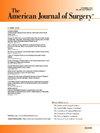使用机器人方法进行尾状叶和后上段肝切除术。疑难部位肝切除术的结果分析。
IF 2.7
3区 医学
Q1 SURGERY
引用次数: 0
摘要
背景:尾段和后上段肝切除术是技术上具有挑战性的切除术,尤其是在微创方法中。我们旨在利用本机构的数据库分析孤立尾状切除术(ICR)、右/左肝叶切除术(ECR)和后上段切除术(PSR)的疗效:在获得 IRB 批准后,我们对 2013 年至 2023 年间接受机器人肝切除术的 500 例连续患者进行了前瞻性随访。后上段包括 4 A、7 和 8 段。数据以中位数(平均值±标准差)表示:结果:在纳入本研究的 500 例患者中,19 例(4%)接受了 ICR,65 例(13%)接受了 ECR,131 例(26%)接受了 PSR。与 ICR 和 PSR 相比,ECR 的手术时间明显更长、EBL 增加、LOS 延长。与ECR和PSR相比,接受ICR的患者手术时间最短、EBL最低、LOS最短:结论:机器人切除位于难切区段的肝脏肿瘤安全可行,临床和肿瘤学效果极佳。只要具备适当的专业知识,就不应避免采用微创方法进行这些手术。本文章由计算机程序翻译,如有差异,请以英文原文为准。
Caudate lobe and posterosuperior segment hepatectomy using the robotic approach. Outcome analysis of liver resection in difficult locations
Background
Caudate and posterosuperior hepatectomy are technically challenging resections, especially in a minimally invasive approach. We aimed to analyze the outcomes of isolated caudate resection (ICR), en-bloc caudate resection with right/left hepatic lobectomy (ECR), and posterosuperior segment resection (PSR) using our institutional database.
Methods
Following IRB approval, we prospectively followed 500 consecutive patients between 2013 and 2023 who underwent robotic hepatectomy. Posterosuperior segments include segment 4 A, 7, and 8. The data are presented as median (mean ± standard deviation).
Results
Of the 500 patients included in this study, 19 (4 %) underwent ICR, 65 (13 %) underwent ECR, and 131 (26 %) patients underwent PSR. ECR was associated with significantly longer operative time, increased EBL, and longer LOS when compared with those of ICR and PSR. The patients who underwent ICR had the shortest operation duration, lowest EBL, and shortest LOS compared to ECR and PSR.
Conclusions
Robotic resection of liver tumors located in difficult segments is safe and feasible with excellent clinical and oncological outcomes. With appropriate expertise, a minimally invasive approach to those operations should not be avoided.
求助全文
通过发布文献求助,成功后即可免费获取论文全文。
去求助
来源期刊
CiteScore
5.00
自引率
6.70%
发文量
570
审稿时长
56 days
期刊介绍:
The American Journal of Surgery® is a peer-reviewed journal designed for the general surgeon who performs abdominal, cancer, vascular, head and neck, breast, colorectal, and other forms of surgery. AJS is the official journal of 7 major surgical societies* and publishes their official papers as well as independently submitted clinical studies, editorials, reviews, brief reports, correspondence and book reviews.

 求助内容:
求助内容: 应助结果提醒方式:
应助结果提醒方式:


